
I find sketching to be an antidote to the high-tech, socially networked, Instagrammed world we live in. After a year of sketching in a small sketchbook I decided to go larger, but this meant upgrading my equipment. I’d been looking for a plein air rig that would do the trick, and went through several setups – none of which were satisfactory for portable, streetwise sketching. I bought a Joe Miller easel off Ebay but it was way too rickety and heavy to do the trick. I also tried a vintage Grumbacher French Easel Model 286, but it was again way too cumbersome for street work with watercolor.
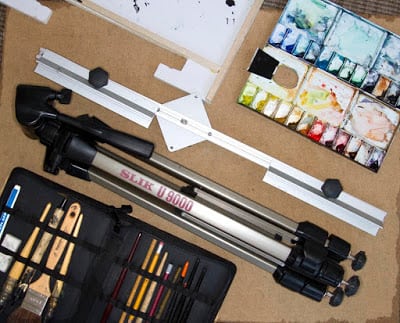
After talking with many painters and sketchers, and searching long hours on-line, I came up with the rig you see in these photos. The brace is a Geurilla Painter #17 FlexEasel, from Geurrilla Painter LLC in Colorado. It’s lightweight but sturdy aluminum and has good gripping braces top and bottom, and folds up slim. It has a standard screw that fits any tripod, or you can attach a quick-release plate that works great.
For my first field-test of the equipment I went Sunday morning to Chinatown, at the corner of Rutgers and East Broadway.
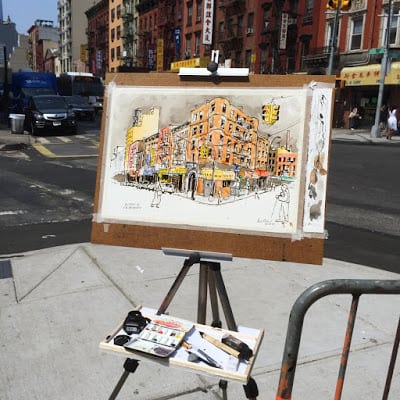
To find the right tripod I went to B&H on 9th Avenue between 33rd and 34th Streets, which has the most comprehensive selection of brands and models. I settled upon the SLIK U9000 because it was simple, lightweight, and didn’t have the bells and whistles you don’t need for painting. The head tilt handle is handy and easy to grab, and the feet are sturdy rubber but convert to spikes. The easel table I made out of ½ inch Gator Board, cutting notches for the tripod attachment. I used balsa wood strips from New York Central Art Supply, pasting them on the rim of the table so paints and brushes do not fall off.
My second test was in the pockmarked streets of Willets Point, Queens, an incredible New York City neighborhood of car repair shops and junkyards in the shadow of Citi Field.
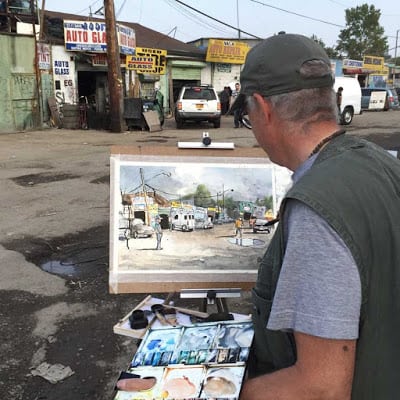
The Willets Point neighborhood’s days are numbered due to pending development near the Citi Field stadium. One of the workers looked at my painting and said, “This will remember us long after we are gone!”
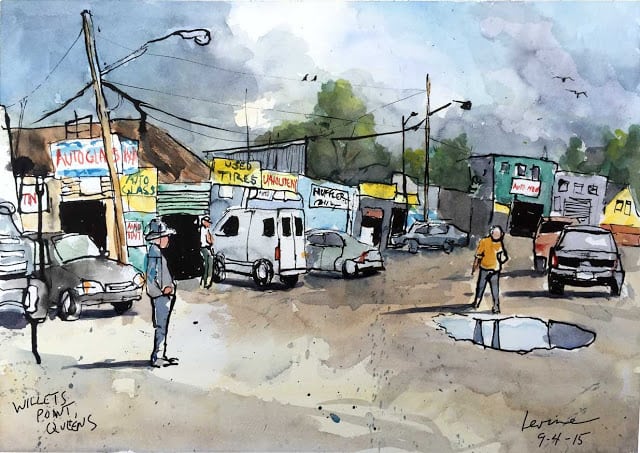
As far as the rest of the materials, the paints go in an old cigar box, the brushes go in a simple zip-up wallet, and the palette is a lovely Holbein folding enameled metal Model #500, also from New York Central. Everything fits fine in a Rolser two-wheeled trolley, the kind you see little old ladies walking around with. Paper goes snug between 2 pieces of Gator Board, along with my Masonite panel to paint on, and these get attached to the cart with a bungee cord.
On Labor Day I went to Bethesda Fountain, setting up early to avoid the crowds. Unfortunately even at 8 AM there were quite a number of tourists.

In the early 19th Century, Ned Ludd led the march to smash machines of the industrial revolution that were replacing skilled craftsmen. Urban Sketching is my way of being a modern-day Luddite. To create my work I use nothing electronic that needs batteries or a cord to charge up – just paint, brushes, and street life of New York City. An exhilarating, refreshing way to work.
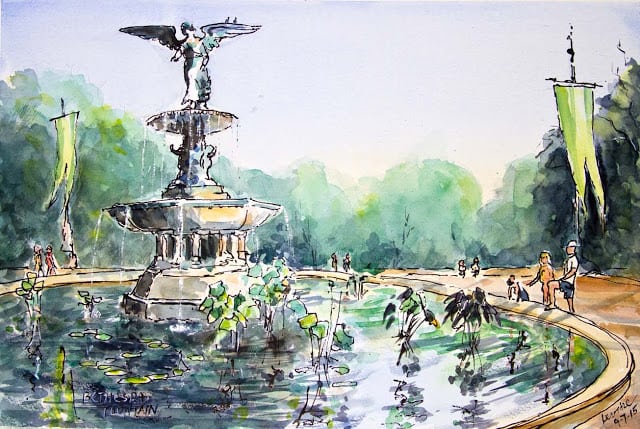
So Sketchers, enjoy the Summer, and I hope to see you all soon!
* * * * * * * * * * * * * *

Thanks for sharing and your inspiring art. Looks like a good set up. How large is your paper, gator board, and Masonite panels?
Thanks for the question Mike. I switched entirely to half inch gator board that is sized at 12×15 inches. This is the handiest size for me in the outdoors but I frequently use smaller cut-down sheets for smaller waterolors.
Well said,and well sketched.
Thank you Jerrry!